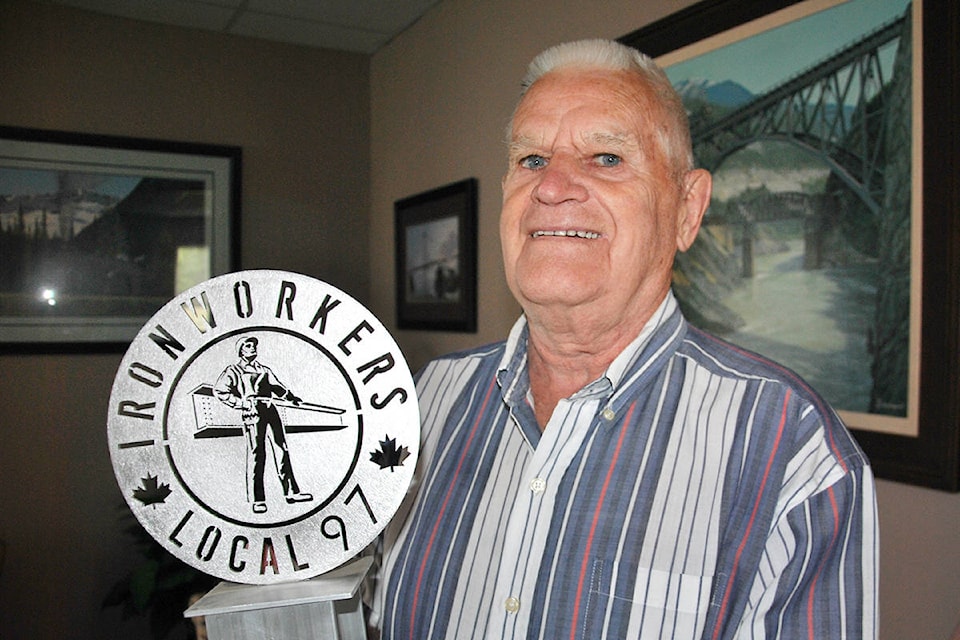Lou Lessard is the last surviving ironworker who was there when the Second Narrows Bridge collapsed during construction on June 17, 1958.
On that day, he remembers the world giving way under his feet and the taste of the sediment-filled water as he swam for his life after the bridge crumpled and fell into Burrard Inlet.
On Monday, Ironworkers Local 97, along with elected officials and ironworkers from across the country, will gather to commemorate the 66th anniversary of the Second Narrow Bridge collapse when 79 workers plunged into the water, and 18 ironworkers and one rescue diver died. The bridge was renamed the Ironworkers Memorial Second Narrows Crossing 30 years ago.
Also attending the ceremony was Byron Maine, a painter inspector on the bridge that day, as well as various dignitaries.
In a 2019 interview with the Langley Advance Times, Lessard, 90 at the time, told about his experience.
“It was a day like any other day,” as he tells it, recalling it was a hot day.
Just before 3 p.m., in his capacity as the front end foreman, he gave the order for his team of 10 men to unload 55 ton of steel that needed to be moved from a train car to position on the bridge deck.
It was rather late into the day to undertake such a project. And, Lessard knew it meant it was going to be a long, gruelling afternoon and evening – as once they started the unload, they had to complete it. Nevertheless, they’d opted to power through.
He suffered internal injuries, cuts, bruises, broken arm, and shattered left femur when he plunged into the Burrard Inlet as the partially built Ironworker’s Memorial Second Narrows Bridge he was working on collapsed around him on June 17, 1958. He fell close to 150 feet to the water below, then torpedoed another 35 feet below the water’s surface.
He and other workers were wearing life jackets, but he hit the water with such force that it was ripped off on impact.
“I was lucky. I was at the edge of the bridge, I fell free from the wreckage. Otherwise, I would have been dead, too,” Lessard shared.
“That probably saved my life,” he said, noting that in his post on top of the bridge, where they were laying the beam, there was nothing overhead that could fall on him when everything started collapsing.
When he got to the surface, he started to realize the immensity of the devastation.
“I could see all sorts of men screaming and crying for their life,” he said, noting others were buried under steel, and more floating dead on the surface.
Lessard just kept thinking he needed to survive – he had a young child at home depending on him.
He cast around with his one usable arm for some broken pieces of wooden that were bobbing along the water. If he could shove one under each armpit, they could work as flotation devices, he thought.
“I grabbed a couple planks and saved myself and when I looked around, I see what has happened, with all those guys there, bleeding, getting hurt, bodies floating on the water, and the whole bridge down, partly underneath the water.”
He’s not sure how long he was floating amid the debris and carnage, but at some point he was picked up by a boat and taken to the dock where off-duty firefighters jumped to his aid.
They hoisted him on a stretcher, loaded him in the back of their pickup truck, and raced him to the Lions Gate Hospital.
“They were going to cut my leg off,” Lessard remembered the doctors saying as he convulsed in shock and cold as his clothes were cut off his body and the medical staff began to work.
They saved the leg and he was four months in hospital recuperating. He returned to work on crutches.
• VIDEO: BC Building Trades video of bridge collapse survivors
Despite such a close brush with death, he had full confidence in the engineers and was convinced the problem had been resolved. The issue was discovered to be a miscalculation by a junior engineer, according to the Royal Commission investigating the incident.
“That accident didn’t bother me at all. I went right back to work,” he said, noting that he attends the special memorial service every year to remember his fallen coworkers and comrades.
“We promised those guys that we were never going to forget about them. We are always going to remember them and their families, for the sacrifices that they did. That is important to me. We made a promise,” he said back during the 2019 interview.
Scaling steel beams hundreds of feet above the rest of the world was where Lessard always felt comfortable.
Oldest of nine siblings, Lucien (Lou) started out working as a millwright. It wasn’t until he was 21 and watching some men climbing around on the steel beams of a mall under construction near his work that he realized this was really what he wanted to do with his life.
That career choice ultimately brought him west, to B.C. where he went on to work for another 40 years building more bridges, as well as schools, pulp mills, mines, towers, and even the first gondola at Grouse Mountain.
The Second Narrows Bridge was renamed the Ironworkers Memorial Bridge on June 17, 1994, to honour the 18 workers, one diver, and four subsequent bridge workers who died during construction.

